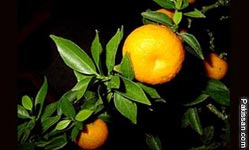|
How to enhance citrus export
By Ahmad Fraz Khan
 THE
citrus, mainly kinnow, export season is at its fag end and
has proved to be a mixed blessing for the country. On the
one hand, almost 10 per cent of the crop was lost to the
alternate bearing factor and weather vagaries. THE
citrus, mainly kinnow, export season is at its fag end and
has proved to be a mixed blessing for the country. On the
one hand, almost 10 per cent of the crop was lost to the
alternate bearing factor and weather vagaries.
On the other, both the phenomena improved weight and quality
of the fruit, as trees had to support less number of fruits,
and the country ended up earning almost 30 per cent
additional foreign exchange because of better international
prices.
According to market figures, which are not absolute, so far
300,000-325,000 tons of citrus fruit was exported against an
informal target of around 400,000 tons. The export figures,
so far, are almost identical to those of last year, but
earnings are up to $120 million against $90 million last
year.
The uncertainty about the finality of both the figures –
volume and value – comes from by road exports (read
smuggling) to Iran and Afghanistan. No one knows how much
citrus has gone to both these states, and at what price. But
formal figures – less in quantity and more in earnings –
create optimism for the country and its exporters.
However, the export pattern necessitates some long-term
changes in production and handling of the fruit. For the
last many years, citrus exports are on the rise. New markets
have been found and a niche has been created in them.
Exporters hope that the trend would not only hold but also
expand in years to come, especially if some steps are taken,
like developing new varieties that cater to the existing and
new markets, build required infrastructure and improve
management practices.
For new varieties, there is a need to work on two planks:
for the East European markets and high-end European markets.
During the last few years, Russia and Ukraine have emerged
as the biggest markets for Pakistani kinnow. In a matter of
five years, their share have increased from almost nil to an
over 100,000 tons (around 30 per cent of the total exports).
Both these states need smaller kinnow, which they consume
with liquor for its strong taste and high sucrose content.
Their share is increasing every year.
However, the domestic production is focused on large and
medium size fruit. All efforts have so far been concentrated
on increasing the size and improving the look of the fruit
because Pakistan’s traditional markets – the Middle East and
the Far East – need them. With the Eastern European
countries emerging big markets, there is a need to adjust
domestic production.
For the purpose, Pakistan needs to develop a new variety of
seed that meets the requirements of Russia, Ukraine and
possibly other East European states. Size of fruit can be
controlled with management practices as well. But, it would
be better if the country is somehow able to develop a new
variety that does not grow beyond a certain size. The
exporters hope to expand their share in area because of
similar consumption patterns in the region. From a long-term
perspective, the country needs to expand its citrus gene
pool.
There is also a need to develop a variety that has reduced
caloric value. Consumers, especially in high-end European
markets, have become calorie conscious. With the current
high caloric value, the fruit might not find many buyers in
highly health-conscious European markets. The exporters
have, so far, been targeting Pakistani population in the
European states. The policy has its own benefits, but also
limits the chances of multiplying exports. It is time to
think beyond ethnic population.
Beyond developing new varieties for niche markets, there is
a need to build cool chains in the citrus producing area.
Their absence affects both production and quality, and
worsens the so-called alternate bearing factor – a
phenomenon, which gives better production one year and
reduces it next season. In the absence of storage
infrastructure, farmers use trees as stores and delay their
harvesting till very late. Thus, with late harvesting,
flushes for next crop start emerging on the tree and squeeze
precious resources, effecting both existing and next crop.
Ideally, the trees should be freed by early or mid-February.
But, it is delayed as late as mid or late March.
The situation can only improve if cool chains are build in
the citrus-producing areas and the crop shifted in them on
time. Fortunately, processing industry of the country is
improving and bringing dividends to local sellers. Even this
year, the farmers and sellers made more money in local
market than in exports. Thus the only missing link, as far
as infrastructure in concerned, is cool chain system to help
save the crop.
Exports to European market require a very elaborate system
of quality assurance, and weaving them into the entire
production and supply chain. That needs to be taken care of,
to increase exports much beyond seven to eight per cent of
domestic production, that can easily go up to 20 per cent,
without affecting domestic market.
There are some examples in the world, like Chile, Holland
and Thailand, which multiplied their horticulture exports
within a few years, taking to billions of dollars. Given
Pakistan’s natural endowments – four seasons and fertile
land – it is surprising why it cannot learn from their
experience and increase exports to 20 to 30 per cent of
domestic production.
Courtesy: The DAWN
|
Pakissan.com;
|